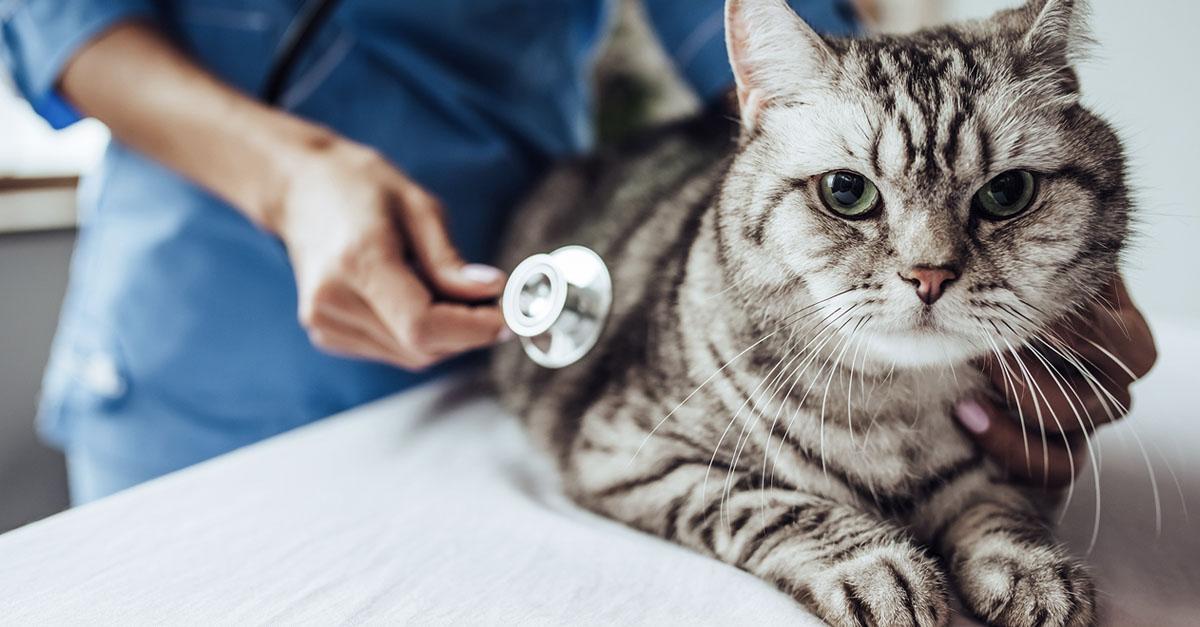Food is an essential part of how people celebrate and connect with friends and family. This is especially true in the autumn months, when Halloween and Thanksgiving festivities fill our candy bowls and tabletops with flavorful people-food favorites.
It’s only natural that people want to extend that love and affection to their pets with a tasty morsel, especially when they wait near the dinner table with big hopeful eyes and a wagging tail. However, many human foods, especially those high in fat, can trigger serious health issues in pets.
Pancreatitis is one such health issue. This painful, debilitating and potentially life-threatening condition is commonly linked to pets eating something they shouldn't have. Here’s what you need to know about pancreatitis prevention (and what to do if you suspect your pet may be affected).
What is a pancreas?
The pancreas is a small but powerful organ located near the stomach and small intestine. It produces enzymes to assist in food digestion and hormones such as insulin, which regulates blood sugar or glucose metabolism.
When the pancreas is working properly, it quietly supports digestion and metabolism. But when it becomes inflamed, those powerful enzymes can start to damage the pancreas itself, leading to a condition called pancreatitis.
What is pancreatitis?
Pancreatitis is the inflammation of the pancreas. It can be acute (sudden and severe) or chronic (developing over time). In both cases, the digestive enzymes meant to activate in the intestines to digest food instead activate inside the pancreas, causing the pancreas to start digesting itself. The associated inflammation allows digestive enzymes from the pancreas to spill into the abdominal cavity, resulting in secondary damage to the liver, bile ducts, gall bladder and intestines.
Pets who recover from an acute episode of pancreatitis may become more susceptible to recurrent bouts of the disease, which is then called chronic or relapsing pancreatitis.
Acute pancreatitis: Symptoms to watch for
Dogs and cats may show different signs, but a rapid onset of symptoms include:
- Vomiting and diarrhea
- Loss of appetite
- Lethargy or weakness
- Abdominal pain (pets may hunch, whimper, or avoid being touched)
- Fever and dehydration
In cats, symptoms may be subtler such as hiding, reduced grooming, or weight loss.
These symptoms are common for a lot of different conditions, which is why it’s best to seek veterinary advice.
Treating pancreatitis early in the disease process can help to minimize long-term complications. In addition to reimbursement on eligible veterinary expenses to treat illnesses like pancreatitis1, Nationwide pet insurance members have access to veterinary advice 24/7 with the Nationwide VetHelpline® app to help determine if your pet needs immediate care.2
What to expect at the veterinary practice
Your veterinarian may recommend blood tests or an abdominal ultrasound to confirm the diagnosis of pancreatitis. If your pet is diagnosed with pancreatitis, treatment typically includes:
- Hospitalization for monitoring and supportive care
- IV fluids to combat dehydration
- Pain relief and anti-nausea medications
- A low-fat diet
Early intervention is key. Pets with mild acute pancreatitis often recover well with dietary changes and supportive care. However, severe cases and chronic pancreatitis will require long-term management and carry a more guarded prognosis.
Did you know? The average cost of pancreatitis in pets is $1,417!3
What to expect at home
To help a pet recover from pancreatitis at home, your veterinarian may recommend providing a quiet and comfortable resting place, prescription medications and a low-fat, easily digestible diet in small, frequent meals to support healing.
Monitor your pet closely for any worsening symptoms and contact your veterinarian immediately if you notice signs like repeated vomiting or a decline in condition.
Lifestyle changes typically include feeding only a low-fat, low-protein diet and pet-safe treats (possibly prescription food) going forward, often including a complete elimination of human food to prevent a relapse. Long-term home care for a pet after pancreatitis involves a strict and highly digestible diet. To help prevent recurrence, avoid table scraps, fatty foods and high-fat treats.
Chronic pancreatitis and long-term complications
Some pets develop chronic pancreatitis, which means long-term episodes of pancreatitis (of varying degrees of severity) can occur. Pets who develop this condition require special vigilance about their diet, including the full elimination of table scraps, to prevent flare-ups.
During an episode of pancreatitis, some pets may also suffer “collateral damage” to nearby organs, such as a blocked bile duct or a damaged small intestine from all the inflammation.
In severe chronic cases, damage to the pancreas can interfere with insulin production, leading to the development of diabetes mellitus that may require daily insulin injections. Another complication is exocrine pancreatic insufficiency which is insufficient production of pancreatic digestive enzymes and creates long-term digestive issues.
Prevention tips for pet parents
Reducing the risk of pancreatitis and preventing its recurrence or flare-ups requires careful attention to your pet’s diet and lifestyle. Here are some tips to consider:
- Choose the right diet: The ideal diet may vary so ask your vet for a recommendation, including safe treat options.
- Say NO to table scraps: This is very important! Make sure all members of the home know to keep human food out of your pet’s reach. During parties or holiday get-togethers, make sure houseguests understand why they cannot slip your pet any unauthorized treats.
- Prevent dietary indiscretions: Take proactive measures to prevent your pet from accessing prohibited food, especially in the trash and on countertops. Also, be vigilant for surprise sidewalk snacks when your pet is enjoying activity outside of your home, like on a walk or at the park.
- Follow veterinary recommendations: Keep up with any recommended veterinary care, especially for the management of chronic pancreatitis. This may include regular monitoring via bloodwork rechecks as well as certain supplements or medications.
Many pets will fully recover and go on to live normal, happy lives. However, the risk of another bout of pancreatitis at some point in the pet’s life remains high.
Did you know?
The day after Thanksgiving is known as “Pancreatitis Friday” within the veterinary community due to the spike in pancreatitis cases.
A better way to share
Food may be how we show love, but when it comes to our pets, sharing isn’t always caring. Pancreatitis is a painful reminder that even well-intentioned gestures can have unintended consequences.
Instead of offering bites from your plate, consider new ways to bond, like playtime, a walk, or a vet-approved treat that looks like it came from your plate. By rethinking how we include pets in our food-centered traditions, we protect their health while still honoring the connection we cherish.
1 Some exclusions may apply. Certain coverages may be excluded due to pre-existing conditions. See policy documents for a complete list of exclusions. Plans may not be available in all states. Policy eligibility may vary. All plans require accident coverage; additional coverage for illness, hereditary & congenital, and wellness is optional. Optional coverage for behavior, prescription food and prescription supplements may also be available. Optional cruciate coverage may be added after the first year of coverage; not available in all states. Pre-existing conditions are not covered.
2Except where prohibited by state law. VetHelpline is not a substitute for a visit to your primary veterinarian.
3Based on Nationwide 2024 claims data. Veterinary bill amount is based on expenses incurred in the first 30 days after initial diagnosis.
















